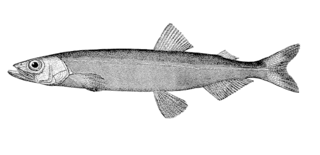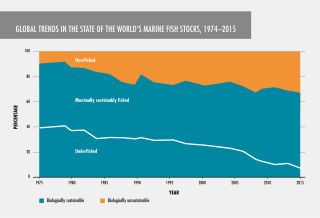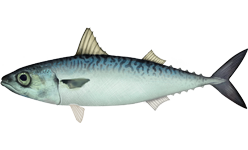
The haddock is a saltwater ray-finned fish from the family Gadidae, the true cods. It is the only species in the monotypic genus Melanogrammus. It is found in the North Atlantic Ocean and associated seas where it is an important species for fisheries, especially in northern Europe where it is marketed fresh, frozen and smoked; smoked varieties include the Finnan haddie and the Arbroath smokie.

Sebastes norvegicus, the rose fish, ocean perch, Atlantic redfish, Norway haddock, golden redfish or pinkbelly rosefish, is a species of marine ray-finned fish belonging to the subfamily Sebastinae, the rockfishes, part of the family Scorpaenidae. It is found in the North Atlantic Ocean. It is a large, slow-growing, late-maturing fish and the subject of a fishery.

The capelin or caplin is a small forage fish of the smelt family found in the North Atlantic, North Pacific, and Arctic oceans. In summer, it grazes on dense swarms of plankton at the edge of the ice shelf. Larger capelin also eat a great deal of krill and other crustaceans. Among others, whales, seals, Atlantic cod, Atlantic mackerel, squid, and seabirds prey on capelin, in particular during the spawning season while the capelin migrate south. Capelin spawn on sand and gravel bottoms or sandy beaches at the age of two to six years. When spawning on beaches, capelin have an extremely high post-spawning mortality rate which, for males, is close to 100%. Males reach 20 cm (8 in) in length, while females are up to 25.2 cm (10 in) long. They are olive-colored dorsally, shading to silver on sides. Males have a translucent ridge on both sides of their bodies. The ventral aspects of the males iridesce reddish at the time of spawn.

Fish stocks are subpopulations of a particular species of fish, for which intrinsic parameters are traditionally regarded as the significant factors determining the stock's population dynamics, while extrinsic factors are traditionally ignored.

The chub mackerel, Pacific mackerel, or Pacific chub mackerel is a species of fish in the tuna and mackerel family, Scombridae. This species of mackerel closely resembles the Atlantic chub mackerel.

Fish meal is a commercial product made from whole wild-caught fish, bycatch and fish by-products to feed farm animals, e.g., pigs, poultry, and farmed fish. Because it is calorically dense and cheap to produce, fishmeal has played a critical role in the growth of factory farms and the number of farm animals it is possible to breed and feed.
Mowi ASA, formerly known as Marine Harvest ASA, , is a Norwegian seafood company with operations in a number of countries around the world. The company's primary interest is fish farming, primarily salmon, the operations of which are focused on Norway, Scotland, Canada, the Faroe Islands, Ireland and Chile. The group has a share of 25 to 30% of the global salmon and trout market, making it the world's largest company in the sector. Mowi also owns a 'value added processing' unit, which prepares and distributes a range of seafood products, and a number of smaller divisions.
Havfisk is a Norwegian Whitefish fishing, seafood processing and sale company. The company was listed on the Oslo Stock Exchange and has its headquarters in Ålesund, Norway.

The fishing industry in Scotland comprises a significant proportion of the United Kingdom fishing industry. A recent inquiry by the Royal Society of Edinburgh found fishing to be of much greater social, economic and cultural importance to Scotland than it is relative to the rest of the UK. Scotland has just 8.4 per cent of the UK population but lands at its ports over 60 per cent of the total catch in the UK.
Brim hf. is a fishing and fish processing company in Iceland. Brim's headquarters are in Reykjavík where its office and groundfish production are located. The company also runs fish processing plants in two other towns in Iceland, Akranes and Vopnafjörður.

A factory ship, also known as a fish processing vessel, is a large ocean-going vessel with extensive on-board facilities for processing and freezing caught fish or whales. Modern factory ships are automated and enlarged versions of the earlier whalers and their use for fishing has grown dramatically. Some factory ships are equipped to serve as a mother ship.

Domstein is a Norwegian fishing company based in Måløy. The company is controlled by Rolf Domstein.
This page is a list of fishing topics.

Forage fish, also called prey fish or bait fish, are small pelagic fish which are preyed on by larger predators for food. Predators include other larger fish, seabirds and marine mammals. Typical ocean forage fish feed near the base of the food chain on plankton, often by filter feeding. They include particularly fishes of the order Clupeiformes, but also other small fish, including halfbeaks, silversides, smelt such as capelin and goldband fusiliers.
A fish company is a company which specializes in the processing of fish products. Fish that are processed by a fish company include cod, hake, haddock, tuna, herring, mackerel, salmon and pollock.

This article is about cod and other cod-like fishes from the family of Gadidae, such as haddock, pollock and whiting, regarded as food.
Austevoll Seafood ASA is a major Norwegian seafood company.
The Nergård Company is a Norwegian company focusing on the capture, distribution, and sale of fish products. It can trace itself back to a single fishing boat in 1947. It consists of the parent company Nergård AS and nine subsidiaries. Nergård AS was founded in 1972 in connection with the purchase of a new facility in Senjahopen.
Caplin Cove-Southport is a local service district and designated place in Trinity Bay in the Canadian province of Newfoundland and Labrador. Caplin Cove-Southport is approximately 50km from Clarenville.












